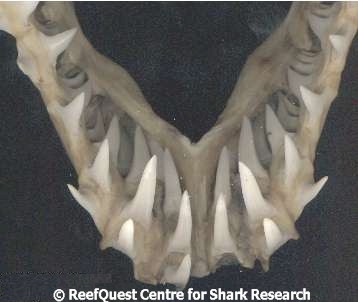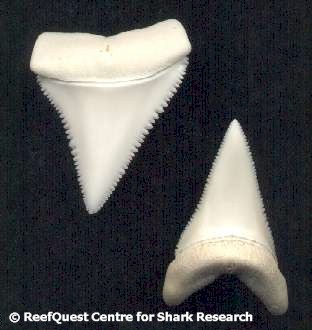Teeth of the Skin
There is much more to dermal denticles than hydrodynamic elegance. As fossil collector Jim Bourdon once so eloquently put it in a letter to me, "Dermal denticles are the Swiss Army knives of elasmobranchs." In addition to providing a covering for the body, shark scales have been modified to a wondrous variety of uses. Several types of sharks have fin spines, which are enlarged dermal denticles sprouting along the leading edge of the dorsal fins that serve to discourage would-be predators. Males of many species have clasper spurs, enlarged denticles that help anchor their intromittant organs inside the female's vent during copulation. Many skates have bucklers, which are enlarged, thorn-like denticles covering parts of the body. In addition, male skates have malar and alar spines, hook-like structures which they use to hang onto females during courtship and mating. Dermal denticles have also been modified along the rostral 'saws' of sawfishes (Pristidae) and sawsharks (Pristiophoridae), forming prey-impaling weapons. Lastly, in some egg-laying sharks - such as the Swell Shark (Cephaloscyllium ventriosum) - the hatchlings develop paired rows of enlarged, rearward-pointing denticles along the the back which act like a rachet, preventing the pup from slipping back into the egg case as it squirms out. These specialized denticles disappear from the young soon after hatching. But of all the uses to which elasmobranch dermal denticles have been put, the most spectacular and infamous is as teeth. Shark teeth are essentially greatly enlarged and modified scales.
As anyone who has examined preserved shark jaws knows, sharks have multiple rows of teeth. There are three basic types of shark teeth: slender, awl-like grasping teeth (as in the Shortfin Mako [Isurus oxyrinchus] and Sandtiger [Carcharias taurus]), blunt, mosaic-like crushing teeth (as in the smoothhound sharks of the family Triakidae), and triangular, blade-like cutting teeth (as in the Great White). In filter-feeding sharks, such as the Basking and Megamouth (Megachasma pelagios), the teeth are greatly reduced in size and significance. However, the broadly triangular, serrated teeth of the Great White are highly important to its predatory success. Although there is some individual variation, the White Shark typically has two or three functional rows of teeth, with 26 teeth in each row of the upper jaw and 24 in each row of the lower. These teeth are arranged in a very prominent "lamnoid tooth pattern". Progressing from the center of the jaws to the jaw corners, most White Sharks have two enlarged anterior teeth, a small intermediate tooth in the upper jaw (but not in the lower), a moderate but noticeable decrease in tooth size to the four lateral (side) teeth, followed by a sharp decrease in tooth size to the six posterior teeth. But this dental complexity is nothing compared to the wonderful way in which sharks develop their multiple rows of teeth.
 |
|
Lower jaw of a Shortfin Mako (Isurus oxyrinchus), showing outermost functional row and inner replacement rows of teeth. |
Like the dermal denticles from which they are derived, shark teeth are grown, shed, and replaced continually throughout their owner's life. The way this is accomplished is nothing short of marvelous. Shark teeth are not set firmly into the jaw, like those of most other vertebrates, nor into the gum tissue itself. Instead, they are formed in a membrane inside the jaw. As each tooth grows and develops, this membrane is pushed forward by replacement teeth developing behind it. Each replacement tooth is slightly larger than the one which preceded it, as though keeping approximate pace with the shark's overall growth. In most sharks, including the Great White, teeth are produced and shed individually. However, in the Cookiecutter Shark (Isistius brasiliensis) - a smallish species notorious for biting plugs of flesh from large pelagic fishes and cetaceans - the interlocking lower jaw teeth are shed and replaced as a unit, ensuring a functional saw-like dentition at all times. However they are shed, the end result of this oral choreography is multiple rows of teeth riding forward in the jaw as though on a kind of dental conveyer belt, providing a shark with a constant supply of fresh, sharp teeth. Not surprisingly, serially replaced teeth is one of the most important defining characters of elasmobranchs. The rate of tooth replacement varies with such factors as water temperature, whether a tooth is from the upper or lower jaw, as well as the age, feeding habits, and species of shark. Tooth replacement rate has been measured in only a few species of shark, ranging from 9 to 36 days per row. In general, the lower the water temperature and older the shark, the slower the rate of tooth replacement.
In 1998, Canadian paleontologist John Clay Bruner presented estimated tooth replacement rates in the White Shark by examining the jaws of 31 specimens, ranging in total length from 4.7 to 15.1 feet (1.4 to 4.6 metres). Bruner's analysis concluded that the average replacement rate of the second anterior teeth differed between upper and lower jaws and between younger and older sharks. He found that in young White Sharks, the average tooth replacement in the upper jaw is about 106 days, while in the lower jaw it was 114 days. Similarly, Bruner found that in older Great Whites, the average rate was 226 days in the upper jaw and 242 days in the lower. The tooth replacement rate of younger White Sharks is probably faster than in older ones because metabolic rate generally decreases with age, thus the tooth-generating membrane forms teeth and grows more slowly in older individuals. Tooth replacement rate in the upper jaw is probably faster than in the lower jaw due to differences in the way each is employed during feeding. The vigorous side-to-side head shaking that the White Shark employs when tackling large prey maximizes the efficiency of the saw-like cutting edge of the broad upper teeth. Because this action imposes greater wear-and-tear on the upper teeth compared with the lower, they need to be replaced more frequently.
|
|
The shape of a shark's teeth often strongly influences its prey types. As in most other lamnoids, the White Shark's teeth become broader with age. This change is most noticeable in the upper teeth, but occurs to a lesser degree in the lower teeth as well. Young White Sharks thus have narrower teeth than older individuals. In addition, the teeth of very young White Sharks have a small but distinct basal cusplet on either side of the main blade. Such narrow teeth with basal cusplets are well suited to grasping slippery-bodied prey that can be swallowed whole. In keeping with this expectation, dietary studies of White Sharks in several locations around the globe have revealed that juvenile White Sharks feed primarily on fishes. The broad upper and lower teeth of older White Sharks are well adapted to slicing bite-sized gobbets of flesh from creatures too large to be swallowed whole. Dietary studies have also revealed that mature Great Whites take large, powerful marine mammal prey far more often than do immature individuals.
From the perspective of form and function, perhaps the most fascinating aspect of the White Sharks's teeth concerns their ultrastructure. In a intriguing 1974 paper, functional morphologist Holger Preuschoft teamed with paleontologists Wolf-Ernst Reif and Wolf Müller to study the structural adaptations of shark teeth. Preuschoft and his co-workers found that the orderly arrangement of crystal fibers varies from species to species and that the teeth of the Great White display the most complex structure of any shark they studied. The White Shark's dentine contains several different mineral fiber layers, but they are all arranged so that the fibers diverge as they near the cutting edge of the tooth blade, thereby spreading the tremendous impact and sheering forces imposed during biting and sawing apart large prey. This strategy is reminiscent of a breakwater, the structure of which is designed to distribute the titanic forces of ocean waves along the structure's entire length. That the Great White Shark has also hit upon such an elegant solution to the problem of concentrated impacts is yet one more example of bioengineering excellence.

